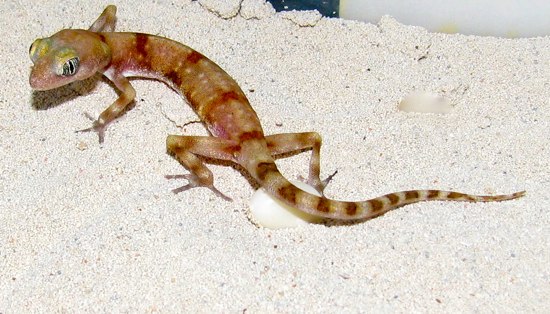What generally sparks my interest in a new species of gecko is its outward appearance, its behaviors, or any other unique characteristics that it may possess. The species I will be writing about is Colopus kochi, and even though I have been working with them for a limited time what fascinates me about them is their ghostly appearance and the characteristic that their eggs go through a very long diapause period, and can take up to two years to incubate. Personally, I took this as a challenge and feel that producing some of these geckos in the relatively distant future would be not only rewarding, but also a serious test in patience. Taking on a new species is not only exciting, it can be extremely educational if the proper research has been done to ensure that your new captive’s husbandry is in line with its specific needs and care. Whether you are attempting to breed this new species or are planning on keeping it to admire its presence is irrelevant in the end as the identical process should go into determining whether you can give the new species what it needs to thrive. Often false assumptions are made that expensive geckos are very fragile and that they are difficult to care for and breed, but this is not always the case. Certain gecko species require much more attention to specific detail than others, while other species such as Colopus kochi can be housed successfully through rather simple and basic desert set-ups.
[ad#sponsor]
What I Need to Know
Curiosity can be a great asset in being successful with any new, unfamiliar gecko. Since Colopus kochi are extremely rare in captivity it’s difficult to acquire different perspectives on husbandry and breeding. To my knowledge, Jon Boone is the only person has successfully bred and produced this species in captivity. That being the case, I have only his personal experience to go by, and due to this I have resorted to other means of obtaining information on this species in order to get a better understanding of them.
I ask myself vital questions such as: Where is this gecko native? What is its native ecosystem like? Is this ecosystem humid or arid? How often is this gecko exposed to precipitation? Does it burrow in a humid or a dry shelter, and on average how deep are its burrows?

Research Results
Colopus kochi is a species from the desert of the skeleton coast of western Africa. There it is exposed to the harsh extremes of this barren land where the climate will fluctuate from extremely hot during the day to brick cold in the evening. Like most desert dwelling geckos the C. kochi lives on a sand substrate, and hides in self created burrows in its extremely desolate habitat. I like to get a nice visual of where the gecko comes from through habitat photos, and I’d like to know what it deals with on a daily basis in regards to predation and by discovering what it primarily feeds on.
Another key step is to obtain climate reports of past seasons. Temperature averages, precipitation charts, humidity information, and UV indices are all valuable information. Colopus kochi comes from the Western coast of Africa where dew creating humidity rolls off the frigid ocean and settles in their habitat almost daily, giving them a regular opportunity to obtain moisture. Knowing whether the species is diurnal, nocturnal, or crepuscular is also very relevant. Being nocturnal, Colopus kochi does not require any UV light to be successfully kept. All of these factors go into a yearly plan on how I will keep this species in each season, and will also determine the conditions of their brumation period once winter arrives. In my opinion this is a great way to start and can be a wealth of information that can only lead to success in the housing, as well as success in the propagation of these lanky geckos.
Generally speaking desert species are simple, easy, and in my experience they all have nearly identical care requirements. Aside from a thermal gradient, the correct food and water, all that these species tend to need is a hot spot in the 90’s, a sand substrate, and a single hide on the hot side and one hide on the cooler side of their enclosure. As mentioned earlier extreme, and occasionally sudden climate fluctuations crossed with drought tolerance, are reasons why desert species need to be hardy in order to survive in their surroundings.
In the short period in which I have kept these geckos I have come to truly appreciate their original beauty and their quirky behaviors. For such a thin and fragile gecko they are not only ravenous eaters but for their size they can devour large prey items. Coming from such a remote area with no plant life and almost no other life, they can survive on very little food. These geckos are very intelligent, funny, and entertaining to watch. They associate my presence with food and will look me in the eyes and beg for food! In the near future I predict that more and more African geckos will make their presence known in the hobby, and even though Colopus kochi will never be common, there are other beauties from the genus that I’m sure will be!


I’ve known Oli for quite some time now but I still don’t know what exactly is a Raw Dog Reptile? Why is the dog raw? Does he have mange? Fleas? Maybe some ointment would make him less raw? A trip to the vet perhaps? Or even just a bath?